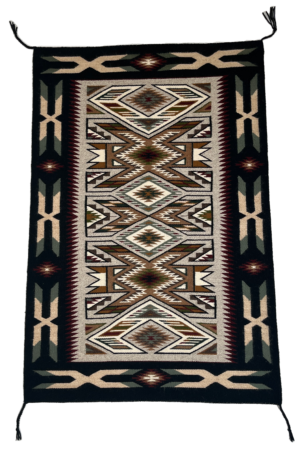Teec Nos Pos style weaving rose to prominence in 1905. This weaving style draws upon Persian rugs with intricate, busy patterns and bright colors such as greens, blues, oranges, and reds. Often these textiles are woven with commercial yarns; they were brought into popularity by traders who prompted Navajo weavers to switch from blankets to rugs.
The design style has ambiguous roots, according to H.L. James’ “Posts and Rugs: The Story of Navajo Rugs and Their Homes.” Some are convinced that a San Juan missionary, Mrs. Wilson, was responsible for its prevalence, while others credit Hambleton Bridger Noel, otherwise known as Trader Noel, who established his trading post in the remote Teec Nos Pos area, west of Shiprock.
Regardless of how the Teec Nos Pos style became so prevalent, this style of weaving is often called the “least Navajo” of all regional styles, although the craftsmanship required to weave the highly detailed patterns often meant that rugs could take up to two years on a traditional loom.
“The People’s Tapestry: Weaving Tradition in Navajo Culture,” on display starting Friday, June 23 at the Moab Museum, features a variety of Navajo textiles styles, including the Teec Nos Pos. In this column throughout the summer, the Moab Museum team will shed light on the background and stories behind these beautiful weavings.
This exhibition is a celebration of the magnificent weavings created by the Diné (which means “the people” in Navajo). Diné textiles reflect the concept of hózhóó, or balance and harmony, expressed in primarily symmetrical designs. The significance of Diné textiles transcends artistic expression; weavers beautify their world through the spiritual act of weaving and integrate their art into the web of everyday life. The Navajo weaver’s song declares, “With beauty, it is woven.”
The Moab Museum is dedicated to sharing stories of the natural and human history of the Moab area. This is part of a series highlighting distinct textiles and styles displayed in the Museum’s temporary exhibition “The People’s Tapestry,” displayed summer-fall 2023. To explore more of Moab’s stories and artifacts, find out about upcoming programs, and become a Member, visit www.moabmuseum.org.




